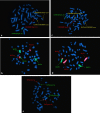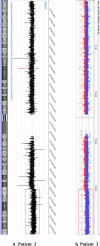Two rare cases of acute myeloid leukemia with t(8;16)(p11.2;p13.3) and 1q duplication: case presentation and literature review
- PMID: 32863883
- PMCID: PMC7448493
- DOI: 10.1186/s13039-020-00507-0
Two rare cases of acute myeloid leukemia with t(8;16)(p11.2;p13.3) and 1q duplication: case presentation and literature review
Abstract
Background: Acute myeloid leukemia (AML) is a complex hematological disease characterized by genetic and clinical heterogeneity. The identification and understanding of chromosomal abnormalities are important for the diagnosis and management of AML patients. Compared with recurrent chromosomal translocations in AML, t(8;16)(p11.2;p13.3) can be found in any age group but is very rare and typically associated with poor prognosis.
Methods: Conventional cytogenetic studies were performed among 1,824 AML patients recorded in our oncology database over the last 20 years. Fluorescence in situ hybridization (FISH) was carried out to detect the translocation fusion. Array comparative genome hybridization (aCGH) was carried out to further characterize the duplication of chromosomes.
Results: We identified three AML patients with t(8;16)(p11.2;p13.3) by chromosome analysis. Two of the three patients, who harbored an additional 1q duplication, were detected by FISH and aCGH. aCGH characterized a 46.7 Mb and 49.9 Mb gain in chromosome 1 at band q32.1q44 separately in these two patients. One patient achieved complete remission (CR) but relapsed 3 months later. The other patient never experienced CR and died 2 years after diagnosis.
Conclusion: A 1q duplication was detected in two of three AML patients with t(8;16)(p11.2;p13.3), suggesting that 1q duplication can be a recurrent event in AML patients with t(8;16). In concert with the findings of previous studies on similar patients, our work suggests that 1q duplication may also be an unfavorable prognostic factor of the disease.
Keywords: 1q duplication; Acute myeloid leukemia; Prognostic factor; t(8;16)(p11.2;p13.3).
© The Author(s) 2020.
Conflict of interest statement
Competing interestsThe authors declare that they have no competing interests.
Figures




Similar articles
-
Acute myeloid leukemia with t(8;16)(p11.2;p13.3)/KAT6A-CREBBP in adults.Ann Hematol. 2019 May;98(5):1149-1157. doi: 10.1007/s00277-019-03637-7. Epub 2019 Feb 13. Ann Hematol. 2019. PMID: 30759270 Clinical Trial.
-
Pediatric acute myeloid leukemia with t(8;16)(p11;p13), a distinct clinical and biological entity: a collaborative study by the International-Berlin-Frankfurt-Munster AML-study group.Blood. 2013 Oct 10;122(15):2704-13. doi: 10.1182/blood-2013-02-485524. Epub 2013 Aug 23. Blood. 2013. PMID: 23974201 Free PMC article.
-
[Acute myeloid leukemia with translocation t (8;16) (p11;p13) and prominent coagulation abnormalities at onset: case report and review of literature].Zhonghua Xue Ye Xue Za Zhi. 2024 Dec 30;45(S1):73-76. doi: 10.3760/cma.j.cn121090-20241130-00503. Zhonghua Xue Ye Xue Za Zhi. 2024. PMID: 40032343 Review. Chinese.
-
Duplication of isodicentric chromosome 13, idic(13)(p11.2), leading to pentasomy 13q in acute myeloid leukemia without maturation.Cytogenet Genome Res. 2013;140(1):21-8. doi: 10.1159/000350694. Epub 2013 Apr 23. Cytogenet Genome Res. 2013. PMID: 23615042
-
t(7;12)(q36;p13) and t(7;12)(q32;p13)--translocations involving ETV6 in children 18 months of age or younger with myeloid disorders.Leukemia. 2001 Jun;15(6):915-20. doi: 10.1038/sj.leu.2402121. Leukemia. 2001. PMID: 11417477 Review.
Cited by
-
Chromosomal aberrations and prognostic analysis of secondary acute myeloid leukemia-a retrospective study.PeerJ. 2023 May 15;11:e15333. doi: 10.7717/peerj.15333. eCollection 2023. PeerJ. 2023. PMID: 37214104 Free PMC article.
-
CREBBP alterations are associated with a poor prognosis in de novo AML.Blood. 2023 Apr 27;141(17):2156-2159. doi: 10.1182/blood.2022017545. Blood. 2023. PMID: 36634304 Free PMC article. No abstract available.
-
Duplication of chromosome 1q32.1q44: presented with ventriculomegaly and transient myeloproliferative disorder of the newborn.Case Rep Perinat Med. 2025 May 28;14(1):20240031. doi: 10.1515/crpm-2024-0031. eCollection 2025 Jan. Case Rep Perinat Med. 2025. PMID: 40453195 Free PMC article.
References
-
- Cancer Research UK. Acute myeloid leukaemia (AML) incidence statistics. 2018. https://www.cancerresearchuk.org/health-professional/cancer-statistics/s.... Accessed 31 Aug 2018.
LinkOut - more resources
Full Text Sources
Miscellaneous

